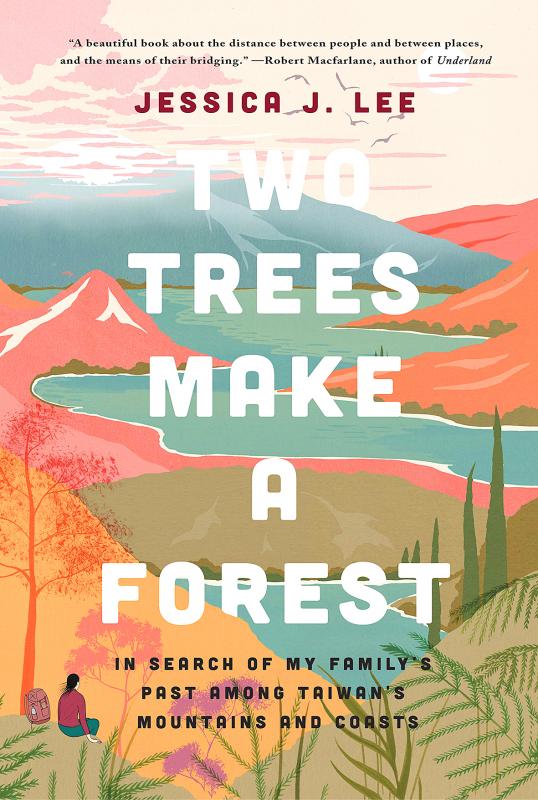Early on in this memoir the author comments on Taiwan’s rich flora — that it came from many places, washed ashore or was borne on the winds. Two Trees make a Forest in general takes up this theme with regard to Taiwan’s human population, and proceeds to investigate the author’s ancestors though reference to the nation’s trees and climbing plants.
Jessica Lee’s grandparents moved to Taiwan from China along with the influx of the Chinese Nationalist Party (KMT) forces in 1949. They subsequently moved to Canada, via Wales, though experiencing a strong desire to return to Taiwan in their final years.
In the event, Jessica and her mother come to Taiwan in 2017, after the death of her grandfather Gong. They begin to explore the island, starting in the extreme south, with a special interest is the fauna and flora. Taiwan, they discover, is awash with endemic plant species — those found nowhere else — and 60 percent of its mammals (the Formosan black bear, the Formosan macaques) are unique to the country. Islands encourage this kind of independent evolution, they decide, citing Darwin’s Galapagos Islands and Madagascar.

Interspersed with such thoughts are evocations of Jessica’s grandparents’ arrival in Canada in 1974. Central, too, is a letter left unopened from her grandfather. Its significance is at the beginning a mystery.
An earthquake near the Canadian province of Ontario leads the author to thoughts on how mountains are formed, and how they will, after eons of time, be brought low. Then we’re back to history, to the Japanese occupation of Taiwan and its place in the Pacific “ring of fire” that links it, for better or worse, with its neighbor to the north. Thoughts on landslides follow — facilitated by earthquakes followed by the extremely heavy rain brought by typhoons.
Family anecdotes alternate with researched information about the early botanists who began cataloguing Taiwan’s plants — men like Robert Swinhoe, Augustine Henry and Bunzo Hayata. Meanwhile the author struggles along the high-altitude Nenggao National Trail (能高越嶺古道) in atrocious weather. Then it’s more memories, this time of her grandfather at Niagara Falls, and the mystery letter again.
On a hike up Shuishi Mountain you begin to realize that Jessica Lee is attempting to make sense of her past via an attempt to master the intricacies of Taiwan’s flora. Quite how this will work out isn’t clear, at this stage at least.
Gong, her grandfather, spent World War II piloting a fighter plane for the KMT army, and much space is given to this. While hiking in the hills above Keelung with a Taiwanese-American friend, Charlene, the author then reminisces about her grandmother’s escape from China, via Hong Kong, until she finally meets Gong in Taipei in 1949 while working as a secretary in the office of president Chiang Kai-shek (蔣介石). They married in 1950 and moved to an apartment outside Kaohsiung where Gong had work as a flying instructor.
Jessica’s wanderings next take her to Tainan where, on a bicycle, she hopes to catch sight of some of the rarer coastal birds. She then reads about the East Asian-Australasian Flyway, the migratory route that spans almost the entire globe.
In 1974 Gong, his wife and Jessica’s mother moved from Taiwan to Canada. Gong was 55, and clearance to fly would take five years. But at 60 he would be barred from working as a pilot, so he took work as a factory cleaner near Niagara Falls. Aged 89, however, he returned to a care home in Taiwan, while his wife remained in Canada.
It’s hard to know whether to consider this as a book of serious history interspersed with some nature rambles, or a serious look at Taiwan’s upland flora (and, to a lesser extent, fauna) interspersed with lengthy episodes of family history. If the two halves are judged to be of equal weight, then the question inevitably arises of what, if anything, is the relation between the two.
It’s when the author comes to contemplate attempts to compile complete accounts of Taiwan’s flora that she again confronts the relation between plants and people.
“Plants come to represent us on city streets,” she writes, “in parks, in our poetry and in shared dreams.”
I have to admit I wasn’t entirely convinced by this.
“I imagine, too, the journeys ventured to take those samples: botanists hauling packs and specimens over the same steep trailways I know, and with them I feel closer to something I cannot articulate.”
Hmm. Hard to articulate, or hard to quite get into focus in the first place?
Jessica Lee knows it’s vital she makes a connection between her plants and her people, between the two halves — roughly equal in length — of her narrative. But quite what that connection might be seems to me to elude her, and hence to elude us.
Jessica speaks Mandarin and English, with German as an added fluency following her work as an academic in Berlin. And it’s to Berlin that she finally leaves at the end of the book, while her mother takes a plane to China, for the first time since childhood.
This book has received high praise, with some critics particularly liking the botanical parts, and others finding themselves moved more by the family narrative. I found both aspects of interest from time to time, but it was the lack of any truly credible link between them that consistently unsettled me.
I won’t go overboard in praise of this book in general, therefore. What I would say is that the family tale has several printed equivalents in Taiwan’s recent history, whereas the botanical angle is more of a rarity. So it’s to potential readers with an interest in Taiwan’s trees and plants, and the history of their collection and cataloging, that I think Two Trees make a Forest is, in the final analysis, most likely to appeal.

Beijing’s ironic, abusive tantrums aimed at Japan since Japanese Prime Minister Sanae Takaichi publicly stated that a Taiwan contingency would be an existential crisis for Japan, have revealed for all the world to see that the People’s Republic of China (PRC) lusts after Okinawa. We all owe Takaichi a debt of thanks for getting the PRC to make that public. The PRC and its netizens, taking their cue from the Chinese Communist Party (CCP), are presenting Okinawa by mirroring the claims about Taiwan. Official PRC propaganda organs began to wax lyrical about Okinawa’s “unsettled status” beginning last month. A Global

Youngdoung Tenzin is living history of modern Tibet. The Chinese government on Dec. 22 last year sanctioned him along with 19 other Canadians who were associated with the Canada Tibet Committee and the Uighur Rights Advocacy Project. A former political chair of the Canadian Tibetan Association of Ontario and community outreach manager for the Canada Tibet Committee, he is now a lecturer and researcher in Environmental Chemistry at the University of Toronto. “I was born into a nomadic Tibetan family in Tibet,” he says. “I came to India in 1999, when I was 11. I even met [His Holiness] the 14th the Dalai

We lay transfixed under our blankets as the silhouettes of manta rays temporarily eclipsed the moon above us, and flickers of shadow at our feet revealed smaller fish darting in and out of the shelter of the sunken ship. Unwilling to close our eyes against this magnificent spectacle, we continued to watch, oohing and aahing, until the darkness and the exhaustion of the day’s events finally caught up with us and we fell into a deep slumber. Falling asleep under 1.5 million gallons of seawater in relative comfort was undoubtedly the highlight of the weekend, but the rest of the tour

Music played in a wedding hall in western Japan as Yurina Noguchi, wearing a white gown and tiara, dabbed away tears, taking in the words of her husband-to-be: an AI-generated persona gazing out from a smartphone screen. “At first, Klaus was just someone to talk with, but we gradually became closer,” said the 32-year-old call center operator, referring to the artificial intelligence persona. “I started to have feelings for Klaus. We started dating and after a while he proposed to me. I accepted, and now we’re a couple.” Many in Japan, the birthplace of anime, have shown extreme devotion to fictional characters and